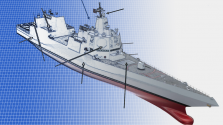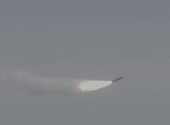You are using an out of date browser. It may not display this or other websites correctly.
You should upgrade or use an alternative browser.
You should upgrade or use an alternative browser.
US Military News, Reports, Data, etc.
- Thread starter tphuang
- Start date
For such a tight grouping, would a single tactical nuke disable all, or is the explosive radius too small?
We will never see a tight grouping like that in a war situation... a creeping sub launching a nuclear torpedo.... pow, game over.For such a tight grouping, would a single tactical nuke disable all, or is the explosive radius too small?
TerraN_EmpirE
Tyrant King
Click bait. The issue is small and stocks exist of reliable replacements. The problem isn’t unique to F35 but American media has swallowed the propaganda of the “reformers” so any F35 issue no matter how small is trumpeted.
Such grouping is only for camera shots. During wartime, every warship involved would be at least tens or hundreds of nautical miles apart.For such a tight grouping, would a single tactical nuke disable all, or is the explosive radius too small?
US Navy awards HII, Bath engineering, design contracts for future destroyer

The Navy unveils a more detailed, but not finalized, concept for its next-generation destroyer, the DDG(X).(Graphic by Breaking Defense; original concept model via US Navy)
WASHINGTON: The Navy has awarded both HII and General Dynamics Bath Iron Works engineering and design contracts for the service’s next large surface combatant dubbed DDG(X).
The Navy did not disclose the dollar value of the contracts citing “source-selection sensitive information,” according to the announcement released late Friday. The contracts are an early but important step for the ship destined to replace the fleet’s workhorse, the Arleigh Burke-class destroyers, because they will result in the blueprints that guide the program for decades to come.
“We are excited to continue on this path with our Navy and industry partners,” Kari Wilkinson, Ingalls Shipbuilding president, said in a statement following the contract award. “It provides us a tremendous opportunity to bring best practices and innovation from our experienced engineering team to the design of this important future surface combatant.”
“Bath Iron Works is eager to bring our cutting edge engineering and design expertise, now applied to the DDG 51 program, to the next generation of large surface combatants,” said Chuck Krugh, BIW president, in a separate statement on Friday. “The opportunity to work alongside HII and our industry partners to meet the Navy’s needs for capability, schedule and cost will result in synergies that build on other extremely successful Navy construction programs.”
Nice copy of the 055US Navy awards HII, Bath engineering, design contracts for future destroyer
View attachment 94520
The Navy unveils a more detailed, but not finalized, concept for its next-generation destroyer, the DDG(X).(Graphic by Breaking Defense; original concept model via US Navy)
WASHINGTON: The Navy has awarded both HII and General Dynamics Bath Iron Works engineering and design contracts for the service’s next large surface combatant dubbed DDG(X).
The Navy did not disclose the dollar value of the contracts citing “source-selection sensitive information,” according to the announcement released late Friday. The contracts are an early but important step for the ship destined to replace the fleet’s workhorse, the Arleigh Burke-class destroyers, because they will result in the blueprints that guide the program for decades to come.
“We are excited to continue on this path with our Navy and industry partners,” Kari Wilkinson, Ingalls Shipbuilding president, said in a statement following the contract award. “It provides us a tremendous opportunity to bring best practices and innovation from our experienced engineering team to the design of this important future surface combatant.”
“Bath Iron Works is eager to bring our cutting edge engineering and design expertise, now applied to the DDG 51 program, to the next generation of large surface combatants,” said Chuck Krugh, BIW president, in a separate statement on Friday. “The opportunity to work alongside HII and our industry partners to meet the Navy’s needs for capability, schedule and cost will result in synergies that build on other extremely successful Navy construction programs.”
US Navy, Air Force running ‘capstone test’ of new high-power microwave missile
ALBUQUERQUE, N.M. — The U.S. Navy and Air Force research laboratories are wrapping up a five-year joint effort to advance high-power microwave technology this summer with two months of testing in California.
The High-Powered Joint Electromagnetic Non-Kinetic Strike Weapon, known as HiJENKS, uses microwave technology to disable an adversary’s electronic systems. The Air Force Research Laboratory and the Office of Naval Research are conducting the capstone tests at Naval Air Station China Lake.
HiJENKS is the successor to the AFRL’s Counter-electronics High-Power Microwave Advanced Missile Project, which completed testing a decade ago. Jeffry Heggemeier, chief of AFRL’s high-power electromagnetics division, told reporters during a June 24 visit to the lab’s Directed Energy Directorate at Kirtland Air Force Base in New Mexico the program builds on CHAMP, taking advantage of new technology that allows for a smaller system equipped for a more rugged environment.
Heggemeier said the program hasn’t yet designated a platform for the weapon, but noted HiJENKS’ smaller footprint means it could be integrated on a wider range of carrier systems.
“We’ll start looking at more service-specific applications once we’ve done this test that demonstrates the technology,” he said.
AFRL is also making progress on a more advanced version of its Tactical High Power Operational Responder (THOR), which uses HPM technology to disable drone swarms that pose a threat to military bases. The next-generation platform is named Mjölnir as an homage to the mythical god Thor’s hammer. AFRL awarded Leidos a $26 million contract in February to develop the Mjölnir prototype and deliver it in early 2024.
Adrian Lucero, THOR and Mjölnir program manager, told reporters during the same June 24 briefing that counter-drone systems are becoming increasingly relevant as unmanned aerial vehicle technology advances.
“There are other effectors out there that are intended to go against drone systems like guns, nets and laser systems,” he said. “But what Thor brings to the table is it has a larger range to affect and it has a decreased engagement time.”
The THOR prototype returned last month from a year of operational testing overseas. While the system was in use, the program team was hard at work developing the Mjolnir upgrades to extend THOR’s range, increase its power by about 50% and improve its usability — recommendations from the Air Force Security Forces who were using it during the deployment.
“We learned a lot of lessons from it being overseas, just working in that operational environment, having Air Force Security Forces airmen pulling the trigger and breaking it,” Heggemeier said.
Lucero and Heggemeier wouldn’t disclose where THOR was deployed, but Lucero said the system proved 94% reliable during its operational assessment, demonstrating its ability “in the real world.”
Once the prototype arrived back in New Mexico, the team disassembled and inspected it and then reassembled it for baseline testing to ensure it’s working as designed. Lucero said the program is now testing the Mjölnir upgrades.
US Air Force conducted another successful ARRW hypersonic missile test this week

he U.S. Air Force successfully tested a Lockheed Martin Corp hypersonic missile this week, sources familiar with the efforts said on Wednesday, amid growing concerns Russia and China have had more success developing their own hypersonic weapons.
